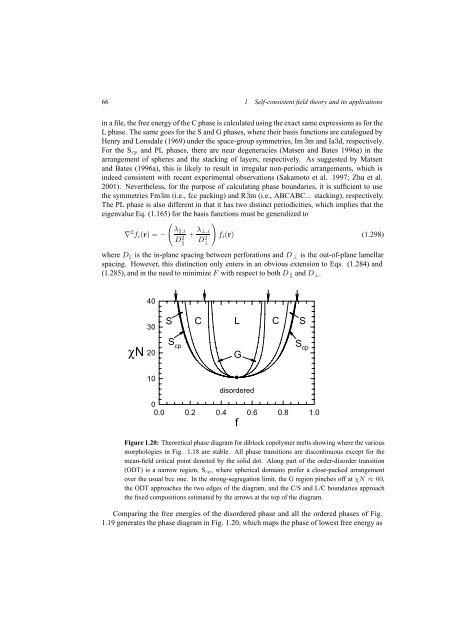Self-Consistent Field Theory and Its Applications by M. W. Matsen
Self-Consistent Field Theory and Its Applications by M. W. Matsen
Self-Consistent Field Theory and Its Applications by M. W. Matsen
You also want an ePaper? Increase the reach of your titles
YUMPU automatically turns print PDFs into web optimized ePapers that Google loves.
66 1 <strong>Self</strong>-consistent field theory <strong>and</strong> its applications<br />
in a file, the free energy of the C phase is calculated using the exact same expressions as for the<br />
L phase. The same goes for the S <strong>and</strong> G phases, where their basis functions are catalogued <strong>by</strong><br />
Henry <strong>and</strong> Lonsdale (1969) under the space-group symmetries, Im ¯3m <strong>and</strong> Ia¯3d, respectively.<br />
For the S cp <strong>and</strong> PL phases, there are near degeneracies (<strong>Matsen</strong> <strong>and</strong> Bates 1996a) in the<br />
arrangement of spheres <strong>and</strong> the stacking of layers, respectively. As suggested <strong>by</strong> <strong>Matsen</strong><br />
<strong>and</strong> Bates (1996a), this is likely to result in irregular non-periodic arrangements, which is<br />
indeed consistent with recent experimental observations (Sakamoto et al. 1997; Zhu et al.<br />
2001). Nevertheless, for the purpose of calculating phase boundaries, it is sufficient to use<br />
the symmetries Fm¯3m (i.e., fcc packing) <strong>and</strong> R¯3m (i.e., ABCABC... stacking), respectively.<br />
The PL phase is also different in that it has two distinct periodicities, which implies that the<br />
eigenvalue Eq. (1.165) for the basis functions must be generalized to<br />
)<br />
(<br />
λ‖,i<br />
∇ 2 f i (r) =−<br />
D‖<br />
2 + λ ⊥,i<br />
D⊥<br />
2 f i (r) (1.298)<br />
where D ‖ is the in-plane spacing between perforations <strong>and</strong> D ⊥ is the out-of-plane lamellar<br />
spacing. However, this distinction only enters in an obvious extension to Eqs. (1.284) <strong>and</strong><br />
(1.285), <strong>and</strong> in the need to minimize F with respect to both D ‖ <strong>and</strong> D ⊥ .<br />
40<br />
30<br />
S<br />
C<br />
L<br />
C<br />
S<br />
χN<br />
20<br />
S cp<br />
G<br />
S cp<br />
10<br />
disordered<br />
0<br />
0.0 0.2 0.4 0.6 0.8 1.0<br />
f<br />
Figure 1.20: Theoretical phase diagram for diblock copolymer melts showing where the various<br />
morphologies in Fig. 1.18 are stable. All phase transitions are discontinuous except for the<br />
mean-field critical point denoted <strong>by</strong> the solid dot. Along part of the order-disorder transition<br />
(ODT) is a narrow region, S cp, where spherical domains prefer a close-packed arrangement<br />
over the usual bcc one. In the strong-segregation limit, the G region pinches off at χN ≈ 60,<br />
the ODT approaches the two edges of the diagram, <strong>and</strong> the C/S <strong>and</strong> L/C boundaries approach<br />
the fixed compositions estimated <strong>by</strong> the arrows at the top of the diagram.<br />
Comparing the free energies of the disordered phase <strong>and</strong> all the ordered phases of Fig.<br />
1.19 generates the phase diagram in Fig. 1.20, which maps the phase of lowest free energy as
















